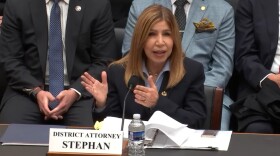
White tailed deer are so common in Washington, D.C., that my kids barely take note, even if I have to slam on the brakes to avoid hitting them.
But the National Park Service says there's a problem beyond the risk of driver-deer collisions, which lead to an estimated $4 billion in damages each year. The overabundance of deer are a threat to native vegetation.
From December through March, wildlife biologists with the U.S. Department of Agriculture, who the park says are "highly trained firearms experts," will get to work thinning out the density of deer in Rock Creek Park. The goal is to reduce the population from its current density of 55 deer per square mile down 15 to 20 deer per square mile.
That's a lot of deer that will be killed, and fortunately, the meat won't go to waste. The park has committed to salvaging deer meat, which is lean and high in protein, for the hungry. (The National Park Service donates meat from population reduction efforts in other parks, as do other government agencies at the local, state and federal level.)
Last season, 3,300 pounds of Rock Creek deer meat was ground and donated to DC Central Kitchen, a nonprofit group that distributes meals to the hungry at homeless shelters and schools. According to spokesperson Erica Teti-Zilinskas, the kitchen's chefs used it in venison chili, venison meatloaf and venison bolognese, served over pasta.
"To address the gamey taste that wild fare sometimes offers, we often marinate venison and these types of proteins with acidic flavors, such as citrus or vinegar," says Andrew Finke, the chief operating Officer of DC Central Kitchen who also oversees all meal distribution. "This method increases the flavor and reduces the cooking time."
Around the country, there are lot of examples of deer meat being salvaged and donated to food banks. In Pennsylvania, a group called Hunters Sharing The Harvest helps hunters distribute their extra venison, using a state-wide network of butchers who help coordinate deliveries to local food banks.
According to Jenny Anzelmo-Sarles, spokesperson for the National Park Service's National Capital Region, government agencies have been linking their deer reduction efforts to food banks seeking protein for years. Not only do they provide the meat, but the agencies also usually pay to have the meat ground and cut by local processors.
Hunters in many states are doing the same thing. In New York State, the Venison Donation Program is a partnership between hunters and the Food Bank of the Southern Tier, which received 6,274 pound of venison in 2013. The donations are made at no cost to hunters.
And, in Indianapolis, according to a report from WISHTV.com, 4,800 pounds of deer meat is expected to be donated to the Gleaner's Food Bank this year. Some of the meat was donated from a private deer hunt in Eagle Creek Park.
Gleaner's Food Bank welcomed the donation, noting that venison doesn't come cheap. If you're paying retail for this meat, you're looking at upwards of $9 a pound.
Copyright 2014 NPR. To see more, visit http://www.npr.org/.






